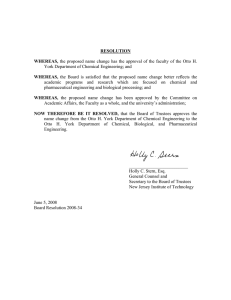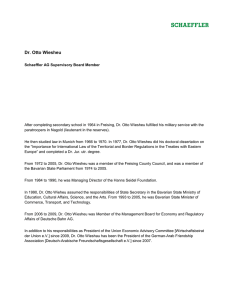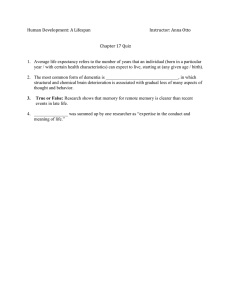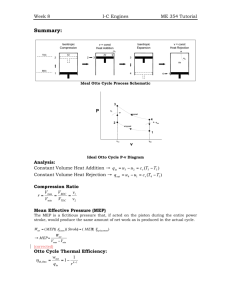Otto von Sadovszky - California State University, Fullerton
advertisement
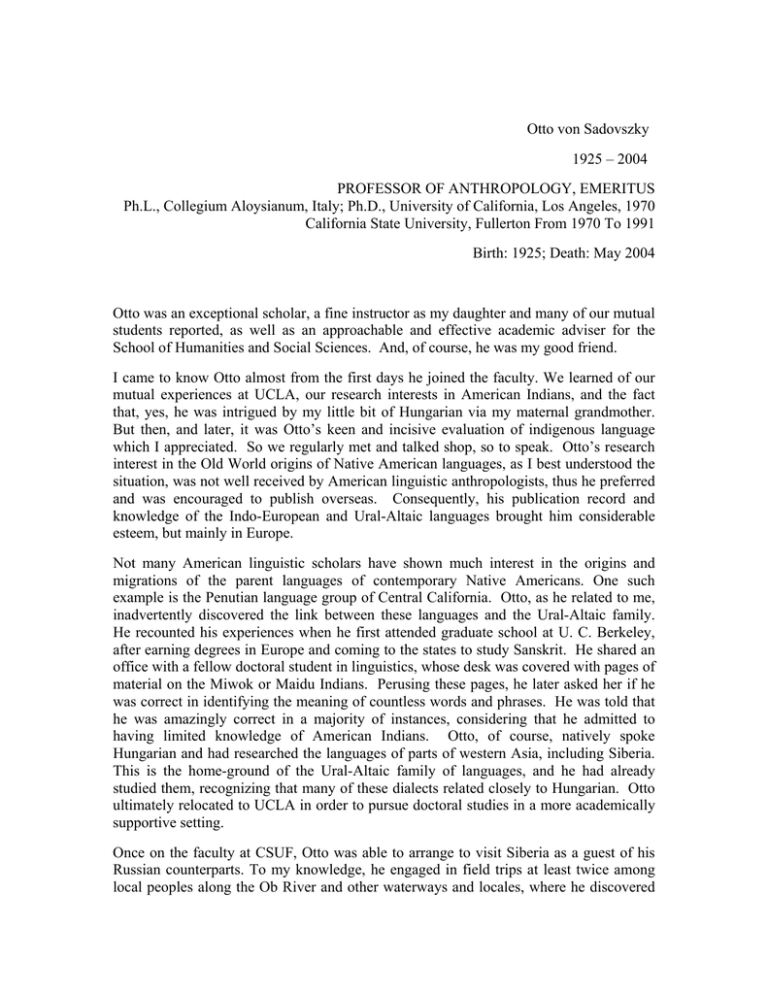
Otto von Sadovszky 1925 – 2004 PROFESSOR OF ANTHROPOLOGY, EMERITUS Ph.L., Collegium Aloysianum, Italy; Ph.D., University of California, Los Angeles, 1970 California State University, Fullerton From 1970 To 1991 Birth: 1925; Death: May 2004 Otto was an exceptional scholar, a fine instructor as my daughter and many of our mutual students reported, as well as an approachable and effective academic adviser for the School of Humanities and Social Sciences. And, of course, he was my good friend. I came to know Otto almost from the first days he joined the faculty. We learned of our mutual experiences at UCLA, our research interests in American Indians, and the fact that, yes, he was intrigued by my little bit of Hungarian via my maternal grandmother. But then, and later, it was Otto’s keen and incisive evaluation of indigenous language which I appreciated. So we regularly met and talked shop, so to speak. Otto’s research interest in the Old World origins of Native American languages, as I best understood the situation, was not well received by American linguistic anthropologists, thus he preferred and was encouraged to publish overseas. Consequently, his publication record and knowledge of the Indo-European and Ural-Altaic languages brought him considerable esteem, but mainly in Europe. Not many American linguistic scholars have shown much interest in the origins and migrations of the parent languages of contemporary Native Americans. One such example is the Penutian language group of Central California. Otto, as he related to me, inadvertently discovered the link between these languages and the Ural-Altaic family. He recounted his experiences when he first attended graduate school at U. C. Berkeley, after earning degrees in Europe and coming to the states to study Sanskrit. He shared an office with a fellow doctoral student in linguistics, whose desk was covered with pages of material on the Miwok or Maidu Indians. Perusing these pages, he later asked her if he was correct in identifying the meaning of countless words and phrases. He was told that he was amazingly correct in a majority of instances, considering that he admitted to having limited knowledge of American Indians. Otto, of course, natively spoke Hungarian and had researched the languages of parts of western Asia, including Siberia. This is the home-ground of the Ural-Altaic family of languages, and he had already studied them, recognizing that many of these dialects related closely to Hungarian. Otto ultimately relocated to UCLA in order to pursue doctoral studies in a more academically supportive setting. Once on the faculty at CSUF, Otto was able to arrange to visit Siberia as a guest of his Russian counterparts. To my knowledge, he engaged in field trips at least twice among local peoples along the Ob River and other waterways and locales, where he discovered 2 that the contemporary language of these communities not only related to Hungarian but to the Penutian languages of central California. He chose to identify them as the ObUgrians, and the latter, the Cal-Ugrians. In 1996, under the auspicies of the Akademiai Kiadô (Budapest) and ISTOR (International Society for Trans-Oceanic Research, Los Angeles) – Otto was President and CEO of the U. S. group --, he published The Discovery of California: A Cal-Ugrian Comparative Study, which is a thorough-going linguistic analysis and historical and contemporary ethnography. Unfortunately, his book has not had wide distribution, so in 2002, I published a short paper that hopefully would draw more attention to his research of the migration history of this group of Native American languages. As I understand the academic perspective of linguistic study of Native America, evidence for marine migration is very limited compared to that overland via the Bering Straits land-bridge. In my estimation, this makes Otto’s findings all the more significant, considering that sea level changes virtually eliminated the possibility of recovering much of the ancient migrations along the North American west coast. Otto’s findings include archaeological as well as ethnological data to back up his linguistics findings. As one of his contemporaries told me, it may take another generation of interested scholars to recognize Otto’s contributions. Selected publications: The Discovery of California: A Cal-Ugrian Comparative Study, Istor 3 (Budapest and Los Angeles, 1996.) Fish, Symbol and Myth: A Historical Semantic Reconstruction, Istor 6 (Budapest and L. A.: 1995). Shamans and Cultures, eds. M. Hoppál, O. J. von Sadvozsky and M. Hoppál, Istor 5 (Budapest and Los Angeles, 1993). “Linguistic Evidence for the Siberian Origin of the Central California Indian Shamanism,” in Hoppál and Sadvozsky, pp. 165-184 (1993). “Siberia’s Frozen Mummy and the Genesis of California Indian Culture,” The Californians, 3(6) 1985. “The Discovery of California: Breaking the Silence of the Siberia-to-America Migration,” The Californians, 2(6) 1984. “Report on the State of Uralo-Penutian Research,” Ural-Altaische Jahrbücher, 48: 191204 (1976). _______________ Imre Sutton, “The Ob-Ugrian/Cal-Ugrian Connection: Rediscovering The Discovery of California,” American Indian Culture and Research Journal, 26(4): 113-120 (2002). 3 _________, “Otto von Sadovszky (1925-2004),” Pre-Columbiana: A Journal of LongDistant Contacts, 3(1-3): 168–69 (Dec. 2003/Jun. & Dec. 2004). Submitted by: Imre Sutton, Professor Emeritus, Geography (CSU Fullerton) October, 23 2010 Standing about six feet two, Hungarian born Otto von Sadovsky was a charismatic, imposing figure, often pacing the corridors of McCarthy hall in animated conversations with students and colleagues alike. Professor of anthropology and linguist, Sadovsky displayed grand theatrical gestures and an unusual command of several Romance, Germanic, and Finno-Ugric languages, all ensconced in a talent for storytelling. Dr. Sadovsky mesmerized generations of California State University students at Fullerton who, for decades, had the luck of landing in one of his classes. I was one such student. His enthusiasm for comparative historical linguistics was infectious, and I was fortunate enough to become one of his student assistants for my senior year in college. During that year Professor Sadovsky painstakingly taught us the rudimentary skills of comparative historical linguistics research. Dr. Sadovsky was very passionate about his work. His life’s work was a detailed comparative study of the languages and cultures of certain Uralic groups of Eurasia, and their apparent association with the languages and cultures of the Penutian Indians of Central California. He coined the term Cal-Ugrian to indicate the connection that he postulated between Asia and Central California (The Discovery of California: A Cal-Ugrian Comparative Study. Istor 3 Budapest. Akademiai Kiado. 1966.) Professor Sadovsky hypothesized that this circum-Pacific connection came about when migrants journeyed by boat from the Ob River delta in Siberia, along the coast of the Arctic Ocean, through the Bering Strait, and down along the North American west coast until they reached the San Francisco Bay area where they finally settled around 500 B.C.. In making their new home in the Bay area, Sadovsky believed, these migrants also established in the area, their language and their culture which they had brought along on their journey, including among other things, the know-how for making bows and arrows, as well as Siberian shamanism. In spite of the many differences of opinion surrounding his work, Professor Sadovsky’s enthusiasm for it remained unabated through the years. He will be best remembered by his students for the great passion that he felt towards it. Submitted by Angela Della Volpe Dean, College of Humanities and Social Sciences, CSU,Fullerton November 30, 2011 4 Dr. Sutton’s TRIBUTE seems to me to cover all the more important academic aspects of Otto’s career. As Imre points out, Otto gained relatively little recognition from the American linguistic “establishment.” This is quite remarkable, since Otto was the first American linguists to convincingly demonstrate a relationship between any Old World language and any New World language. He was already working on this research before he came to CSUF, and it was one of the main reasons we hired him. To put Otto’s findings in perspective, a number of other American linguists, including Edward Sapir, had suggested Old World-New World linguistic relationships – but none had been able to provide convincing empirical evidence that such relationships existed. Otto was able to do so. As Angela Della Volpe, one of Otto’s former students says, he was an excellent and entertaining teacher. On his long and difficult journey from a Hungry under the control of the Communist Party, he spent some time working in the Italian film industry, which probably partially influenced his teaching style. To my knowledge he was the only anthropology faculty member who sometimes sang in class. Submitted by Richard See Associate Professor of Anthropology, Emeritus November 30, 2011
